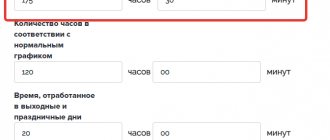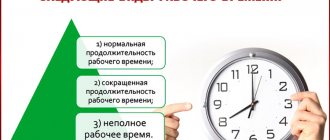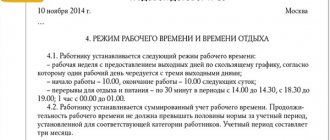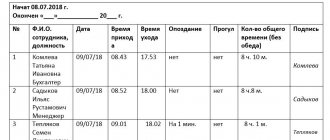1. What is the working time of employees 2. What is the working time regime 3. Forms of working time recording 4. Types of working time recording 5. How to control the working time of employees 6. What is the need for working time recording 6.1 Efficiency 6.2. Discipline 6.3. Automation and security 7. Overtime and fines 8. Conclusion
What is employee working time?
Article 91 of the Labor Code of the Russian Federation states: “Working time is the time during which the employee, in accordance with the internal labor regulations and the terms of the employment contract, must perform labor duties, as well as other periods of time that are in accordance with this Code and other federal laws and other regulatory legal acts of the Russian Federation relate to working time.”
Simply put, work time refers to the time an employee spends performing tasks while on or off the employer's premises (for example, at a work meeting).
Timely
A hybrid of a time tracker and calendar. You can connect a task manager or calendar with your schedule and tasks from there will go to Timely. The principle of operation is the following: you create an event, and then launch a time tracker inside. Frankly speaking, doing this is not very convenient.
The dashboard shows how much time you worked per day, how much money you earned, and how much more you will earn if you work at the same pace. You can work in a team - everyone will track their tasks, and then they will go to the account administrator screen.
The key feature of the service is the Memory Tracker application, which monitors what programs you use and how much time you spend on it. Based on the application data, a completely plausible picture of your working day is obtained. At the end of the day, you can select the apps that were related to the task you were doing at that time and get the exact time you worked.
Timely is only available with a paid subscription, starting at $7 per month.
The concept of working hours
From Article 100 of the Labor Code it follows that working hours mean the employee’s schedule, namely:
- length of the working week (five-day with two days off, six-day with one day off, working week with days off on a rotating schedule, part-time work week);
- work with irregular working hours for certain categories of workers;
- duration of daily work (shift), including part-time work (shift);
- start and end times of work;
- duration of breaks in work;
- number of shifts per day;
- alternating working and non-working days.
All these points are established by the company independently in accordance with labor legislation.
According to Article 56 of the Labor Code of the Russian Federation, the duration of working hours is a mandatory component of the employment contract: the employer must indicate how many hours per week the employee will work. As a general rule, if a person does not belong to preferential categories of citizens (for example, minors, disabled people), his work schedule is 8 hours a day and 40 a week.
The exceptions are those employees who work in shifts. A shift can be 10 or 12 hours, but the total duration for the accounting period - a month, two or more, but not more than a year - should not exceed the standard working time, that is, the total number of hours should not be more than 40 per week.
Hours worked are the time an employee spends at work performing his or her duties.
How to count “nightly” during summarized accounting?
Art. is devoted to work at night. 96 Labor Code of the Russian Federation.
Night time is the time from 22:00 to 6:00.
Firstly, there are categories of workers who are prohibited from being hired to work at night (listed in Article 96 of the Labor Code of the Russian Federation), for example, pregnant women.
Secondly, there are categories of workers who can be recruited to work at night, but only with their consent (Article 96 of the Labor Code of the Russian Federation), for example, women with children under the age of three, mothers and fathers raising without a spouse ( spouses) children under five years of age. Accordingly, when reviewing a schedule that includes night work, such consent must be requested in writing.
Thirdly, there is a special rule: “the duration of work (shift) at night is reduced by one hour without further work.” There are exceptions to this:
1. If employees are specifically hired to work at night, then the duration of their work (shift) at night is not reduced (Part 3 of Article 96 of the Labor Code of the Russian Federation). When hiring, it is necessary to include in their employment contracts a condition on working at night, this is mandatory according to Art. 57 Labor Code of the Russian Federation. So, for example, if an employee works only on night shifts, then this is the case, but if he works on both day and night shifts, then it can no longer be said that he was hired specifically for night work.
2. If employees have a reduced working time (for example, employees working in jobs with harmful and (or) dangerous working conditions, etc.), then the duration of work (shift) at night for them is also not reduced (Part 4 Article 96 of the Labor Code of the Russian Federation). For such workers, a special working time standard has been established - no more than 36 hours per week (Article 92 of the Labor Code of the Russian Federation). The relevant employment contracts stipulate that these employees belong to a category for which the law establishes reduced working hours, and their work schedule is described. You can also indicate in the employment contract that when working at night, their working hours are not reduced in accordance with the Labor Code of the Russian Federation.
3. There is a need to work at night due to working conditions.
The list of such works may be established in local regulations or a collective agreement. The employee must be familiar with them against signature, and the condition on equalizing the time of day and night shifts should be included in the employment contract.
4. In the case of shift work with a six-day working week with one day off (Part 4 of Article 96 of the Labor Code of the Russian Federation).
We will not touch creative workers.
And all this should be taken into account when drawing up a schedule.
In general, the question of reducing night shift time arises only in relation to night shifts. A shift is considered night if at least half of its duration falls at night (clause 9 of the Resolution of the Central Committee of the CPSU, the Council of Ministers of the USSR, the All-Russian Central Council of Trade Unions dated February 12, 1987 N 194 “On the transition of associations, enterprises and organizations of industry and other sectors of the national economy to a multi-shift operating mode in order to increase production efficiency").
Wages for work at night should be increased (Article 154 of the Labor Code of the Russian Federation). At a minimum - by 20% of the hourly tariff rate (salary (official salary) calculated per hour of work) for each hour of work at night (Resolution of the Government of the Russian Federation of July 22, 2008 N 554 “On the minimum amount of increase in wages for work at night ").
The specific amounts of the increase are established by a collective agreement, a local regulatory act adopted taking into account the opinion of the representative body of employees, and an employment contract.
The basis for payment for night work is data from time sheets. And here the typical case is when the shift falls on two calendar days. Hours worked must be entered on the appropriate calendar days. But it is obvious that within one day a shift can include both day and night hours.
The legislation allows us to supplement the unified forms. Therefore, a way out of this situation would be to introduce additional lines.
Example 1 : Security guard shift - from 20.00 to 07.00 the next day (lunch break from 02.00 to 03.00). The following hours are subject to payment at an increased rate: from 22.00 to 02.00 and from 03.00 to 06.00, a total of 7 hours.
According to Art. 108 of the Labor Code of the Russian Federation, during the working day (shift), the employee must be given a break for rest and food lasting no more than two hours and no less than 30 minutes, which is not included in working hours.
Time and attendance forms
According to Olga Polezhaeva, head of the legal consulting practice on labor law and labor protection at ANCOR, there are various tools for monitoring the time actually worked by employees. For example, manufacturing companies often keep logs of visitors, registration of times of arrival and departure, and modern offices are equipped with an access control system, which, in addition to the access function, also records the time of arrival and departure.
However, as a rule, total information on attendances and absences is consolidated by the personnel department in a time sheet. It is according to this that every organization must keep records of how much each employee of the company worked. A company can use its own time sheet, but usually those developed by the State Statistics Committee of the Russian Federation are used:
- Form T
-
12
“Working time sheet and calculation of wages” - is designed for manual entry of information and contains a block for calculating an employee’s salary based on the number of hours worked. - Form T-13 “Working time sheet” is designed for automatic entry of information using computer programs and access control systems, does not contain a separate salary block.
RescueTime
Service for automatic time tracking. You install the application on all the devices you use for work, set your goals there: how much time you want to work per day in one mode or another. RescueTime monitors what applications you use and what sites you surf on during and after work hours, and is quite good at determining whether you were working or procrastinating.
If you work a lot on social media and are confident in yourself, you can tell RescueTime to mark your time spent on social media as productive.
RescueTime has a free plan with a limit on the number of sites and apps it can monitor. The cheapest premium costs $7 per month.
Types of working time recording
Based on the norm of working time, its accounting is divided into:
- Unstacked . This includes a standard 5/2 schedule with a 9-hour working day, where lunch lasts from 45 minutes to 1 hour. A person works the same number of hours each workday, and the days and hours are recorded on a time sheet.
- Summarized . There is no clear fixation on the number of working days and hours worked on these days, the main thing is that the total number of hours worked for the year does not exceed the norm according to the production calendar.
How to control employee working hours
The main formal control tool from a legal point of view is the previously mentioned time sheet. The report card must have the signatures of the head of the structural unit and the HR specialist; it is made in one copy. As a rule, it is kept by the accounting department, where it should be stored.
Other methods of control and management depend on the internal structure of each company. The report card can be filled out by both an HR specialist and a manager. Each company can choose its own authorized person to maintain timesheets.
Office work
Office workers often use special software that provides management with information about the number of hours worked and the time each task is completed. The function of monitoring employee working time is available in CRM systems and hardware and software systems, including:
- Bitrix24 is a kind of “online office” for business management. Developer and provider - .
- Megaplan positions itself as a system for remote work. The arsenal includes: task manager, CRM, business process automation
- Timebook is a WFM (Workforce Management) system for managing working time and timekeeping processes. Created by the Russian IT company of the same name, founded in 2012.
Working outside the office
In addition to “sedentary” work, there are manufacturing, delivery and other areas where people do not work directly at the computer. How are their working hours recorded? For example, with the help of mobile operators - some tariffs allow you to track the location and fulfillment of orders by drivers, couriers and workers who are constantly moving while performing work tasks.
According to Natalya Burchilina, head of IoT at MegaFon, among the main users of HR Control are: retail companies, forwarders, repair crews, companies with sales representatives and courier delivery. “The employer receives the consent of employees to determine their location; MegaFon can provide confirmation functionality via SMS. The protection of the processed data complies with the requirements of the Federal Service for Technical and Export Control of Russia, the databases are located in certified MegaFon data centers,” adds Natalya.
The service also helps set up internal processes, says Burchilina.
For example, employees of a pharmaceutical company promote products in pharmacies. Each one is assigned a pharmacy in a specific area. Thanks to the HR Control solution, it was possible to build effective work: the client received reports and analytical data on the history of employees visiting designated areas and optimized their routes.
Some companies use access system data to calculate working hours, control lateness and overtime. Facial recognition systems are also being developed: NtechLab and Vision Labs are working on them, in particular. They will help make the process simpler and more transparent, because in theory you can give your pass to a colleague or come up with another method of bypassing the restriction.
This system is also useful for employees. For example, in Kaliningrad, the court upheld a claim in which a bank employee asked to be paid for overtime hours. You can win such a case thanks to the company’s internal system, in which it will be clear that, for example, the manager sets tasks after the end of the working day, and the employee immediately starts working on them, thus working overtime.
Photo: Zephyr_p / Shutterstock
Why do you need accounting?
Efficiency
Most systems have a performance measurement feature that is calculated based on tasks completed and time worked. This helps both control working time and optimize processes within the company. You can understand when an employee is most effective, which tasks he completes faster, and which ones require more time and resources. The manager, in turn, uses this data to correctly distribute the workload and set deadlines.
The founder of the outsourcing company Work Solutions, Maxim Mul, believes that the Bitrix24 system, which the company uses, allows you not to “lose” developers’ hours - you won’t be able to watch YouTube during working hours. It also helps clients track how their budgets are spent and makes the collaboration process transparent.
However, despite the expanded functionality of time tracking programs, we must remember that tracking systems will not give anything without regulations and established business processes. For example, Work Solutions prohibits developers from starting tasks with an estimate of more than 8 hours, requiring decomposition. “This is due to the fact that large tasks that do not fit into the working day depress the spirit and often get out of control. To maintain a good emotional mood among the team, you need to monitor such nuances,” says Maxim.
A similar opinion is shared by Maria Ukolova, director of the information technology department of IT.
“The accounting system allows only indirect assessment of employee performance, so we use different approaches and regularly review them. For example, we are carefully engaged in resource planning and even want to switch to predictive write-offs,” says Maria.
Discipline
Many employees work more efficiently if their working hours are clearly recorded and they report on completed tasks. During the pandemic, due to the transition to remote work, programs and sites that record work processes have become more in demand.
Thus, the marketing boosting service Callibri used the TimeDoctor program for about two years to monitor hourly contractors and developers, and with the advent of quarantine, it extended it to all employees. The process went so well that now using TimeDoctor is a prerequisite for working in the company, the company says.
Automation and Security
Using programs, an access system and facial recognition, you can simplify the processes of recording lateness, missed deadlines, absence from work, and overtime. The systems also help maintain trade secrets and make it more difficult for attackers to gain access to corporate data.
Since the opening of the representative office of The MASCC (Czech-Russian IT company) in Moscow, the organization has been using a system for recording employee working hours using contactless cards. It was possible to improve not only discipline (according to company representative Ilya Kharchenko, the number of late arrivals to work was practically reduced to zero, as well as cases of leaving work before the appointed time), but also office safety. Strangers and guests who do not have entry cards must first ring the office intercom and identify themselves. After establishing their identity and the purpose of the parish, they are given or not given the opportunity to enter.
Kickidler
www.kickidler.com habrahabr.ru/company/kickidler Operating principle.
Hidden agents are installed on employee computers, which record video from the screen, keyboard strokes and running applications.
Efficiency is set for each application. The administrator can remotely manage user computers. The main window of the program is a view of employee monitors in real time. Flexible schedule.
The program does not have the ability to set a schedule.
Requests for time off.
Report card. There are no applications or reports for accounting.
Availability of API.
No.
Reports.
Reports show the most used programs and sites.
The reports are not informative, they are not designed to control the work schedule of employees. The reports contain filtering. When viewing employee monitors, up to 16 monitors can be placed on the screen at the same time, which will be a problem if you need to monitor the work of employees in real time in companies with a large staff. OS and DB.
The Kickidler server runs on Windows OS and a PostgreSQL database.
There is a version of the server for Linux, but it has limited functionality. Integration with AD.
No.
Settings.
For the system to work, it is necessary to install the server and agents on user computers.
To access recorded videos, a separate “Viewer” program is used, which must be installed by employees who will monitor the collected data. If the system is deployed locally, then a local licensing server will be required. Multi user multi computer mode.
Identification occurs by user login and workstation name.
Work via the Internet.
For the program to work, you need access to my.kickidler.com, through which the server, grabbers and viewers are synchronized and the license is checked.
For a local installation, this address must point to the local licensing server. SSL support declared. Access to statistics.
It is impossible to provide users with access to statistics for self-control.
Access to statistics and recorded videos occurs through the Viewer program. For the Viewer to work, you need to select in the admin panel which users are allowed access. System bypass.
The script works, activity is taken into account.
Thanks to the use of a random pause, the activity schedule also changes. You can track the use of the script only by watching a video of repeated actions; in this case, making the script more complex will help. For the observable.
The presence of an agent can be determined through the task manager for the processes grabber.exe, grabberAgent.exe, grabberSubAgent.exe.
The default path is C:\Program Files (x86)\TeleLinkSoftHelper. Price.
Cloud version: 500 rubles per month per employee. 10,000 rubles per employee, without time limit. Local version: Price on request.
Overtime and fines for non-compliance with the requirements of the Labor Code of the Russian Federation
“If an employee does not work the required number of working hours, for example, is two hours late for work, then the employer needs to record this moment in the work time sheet and, highly preferably, in an internal memo,” says Ksenia Mikhailichenko, lawyer and head of labor law practice at SZP LAW Boutique. In this case, the employer has the right not to pay for unworked hours. However, if a person was not physically at the workplace, but was performing work duties, for example, was at a meeting, the employee has the right to challenge such an order.
When an employee works more hours, the situation becomes ambiguous. On the one hand, according to the Labor Code, additional hours are considered overtime and are paid accordingly.
However, according to judicial practice, if an employee does not have time to complete his tasks in an eight-hour working day or work shift, and there is no order to employers to involve him in overtime work, such work is not considered overtime.
Delay at work may be due to the slow pace of a person's work or the fact that he is unable to cope with his duties. There will be no additional payment for such work.
If there is an order, additional hours are paid accordingly: the first two hours at 1.5x the hourly rate and subsequent hours at double the rate. There should be no more than 120 hours of overtime per year for each employee, regardless of his job responsibilities.
If an employer assigns an employee work tasks that must be completed after or before the working day (meetings or other assignments), judicial practice evaluates this as follows: these actions are performed by the employee voluntarily, he has the right to get up and leave. You can't fire him for this. Thus, if you are assigned an overtime task, you have the right to refuse it and tell the manager that you will complete it during your working hours, or ask to register this work as overtime.
Peculiarities
During the work process, situations may arise that require a special approach to the distribution of employee working time :
- Weekends and holidays . According to the Labor Code of the Russian Federation, work on weekends and holidays is prohibited. However, labor regulations within an organization may provide for employees to go to work under special conditions (double pay, time off).
. Entered into the timesheet as a separate column.
Overtime work- Forced absenteeism is the absence of an employee from the workplace due to the fault of the employer. After all the circumstances have been clarified, missed work time is paid as if the employee was present and participated in the work process.
- Downtime . They can arise for various reasons, including the fault of the employee. In this case, the employee does not receive any payment for the downtime, and if the downtime was not his fault, he receives full payment for the missed time.
- Incapacity due to illness . In this case, the employee is paid partially.
- The day the business trip ends . On this day, the employee is not required to go to work, but receives travel money.
Conclusion
It is impossible to say unequivocally whether every company needs to automate time tracking, but technical recording greatly simplifies the process and helps monitor the team’s progress.
However, the main legal document for recording working hours remains the time sheet. Using it in conjunction with these programs helps in resolving disputes between an employee and an employer, and can also be useful for both parties to assert their rights in court.
At the same time, we should not forget that in addition to using technology and maintaining timesheets, it is necessary to correctly distribute work tasks at the planning stage.
Cover photo: fizkes, Shutterstock
Let's summarize
Every owner wants to be aware of what his employees are doing and how effectively they use their working time. The oldest and simplest system for recording working hours is the maintenance of special time sheets, but they are not very informative; they only reflect the presence of a person at the workplace.
There are many additional control methods, each of which has its own advantages and disadvantages. You need to choose the optimal method based on the specifics of the organization’s work: in production, a badge system is sufficient; in the IT field, it is more important to keep track of the time spent on a specific task.
In addition to the obvious advantages: increased work efficiency, increased control, the ability to improve accounting; the introduction of a monitoring system has its drawbacks: implementation costs, increased stress levels among employees, deterioration of the psychological climate. All this must be taken into account in order to develop an accounting system that will help to best control time and, based on its analysis, achieve maximum efficiency.








